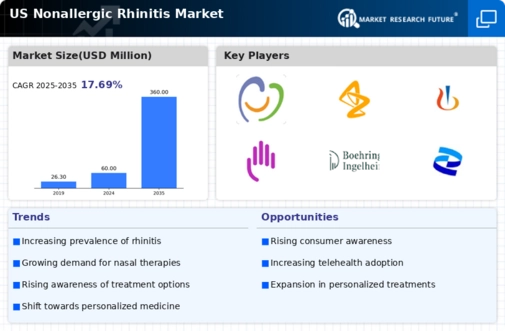Focus on Preventive Healthcare
The growing focus on preventive healthcare is emerging as a significant driver for the nonallergic rhinitis market. As healthcare systems prioritize prevention over treatment, there is an increasing emphasis on early diagnosis and management of conditions like nonallergic rhinitis. This shift is reflected in public health initiatives aimed at educating individuals about the importance of recognizing symptoms and seeking timely intervention. In the US, preventive healthcare spending is projected to increase by approximately 15% over the next five years. This trend may lead to a higher number of patients being diagnosed and treated for nonallergic rhinitis, ultimately expanding the market. By fostering a culture of prevention, healthcare providers can improve patient outcomes and reduce the long-term burden of chronic conditions.
Increasing Healthcare Expenditure
The rising healthcare expenditure in the US is a crucial driver for the nonallergic rhinitis market. As healthcare budgets expand, there is a greater allocation of funds towards the management of chronic conditions, including nonallergic rhinitis. In 2025, healthcare spending in the US is projected to reach approximately $4 trillion, reflecting a growing commitment to improving patient outcomes. This increase in funding allows for enhanced access to treatments and therapies, which may lead to higher rates of diagnosis and management of nonallergic rhinitis. Additionally, as more patients seek medical attention for their symptoms, the demand for effective treatment options is likely to rise, further propelling the growth of the nonallergic rhinitis market. The interplay between healthcare expenditure and patient care is expected to create a favorable environment for market expansion.
Emergence of Digital Health Solutions
The emergence of digital health solutions is reshaping the landscape of the nonallergic rhinitis market. Telehealth services and mobile health applications are becoming increasingly popular, providing patients with convenient access to healthcare professionals. This trend is particularly relevant for individuals managing chronic conditions like nonallergic rhinitis, as it allows for timely consultations and personalized treatment plans. In 2025, it is estimated that telehealth consultations will account for approximately 25% of all outpatient visits in the US. This shift towards digital health not only enhances patient engagement but also facilitates better management of symptoms. As patients utilize these platforms to seek advice and treatment, the nonallergic rhinitis market is likely to experience growth, driven by the increased accessibility of healthcare services.
Advancements in Pharmaceutical Research
Advancements in pharmaceutical research are significantly influencing the nonallergic rhinitis market. The development of new medications and treatment modalities is driven by ongoing research efforts aimed at understanding the underlying mechanisms of the condition. Recent studies have indicated that novel therapeutic agents, including intranasal corticosteroids and antihistamines, may offer improved efficacy and safety profiles. The US market has seen a surge in investment in research, with funding reaching approximately $1 billion annually for respiratory conditions, including nonallergic rhinitis. This influx of resources is likely to accelerate the introduction of innovative products, catering to the diverse needs of patients. As a result, the nonallergic rhinitis market is poised for growth, with a broader array of treatment options becoming available to healthcare providers and patients alike.
Rising Awareness of Nonallergic Rhinitis
The increasing awareness surrounding nonallergic rhinitis is a pivotal driver for the nonallergic rhinitis market. As healthcare providers and patients become more informed about the condition, the demand for effective treatment options rises. Educational campaigns and resources provided by health organizations contribute to this awareness. In the US, it is estimated that approximately 20 million adults suffer from nonallergic rhinitis, which underscores the need for targeted therapies. This growing recognition is likely to lead to an uptick in consultations and prescriptions, thereby expanding the market. Furthermore, as patients seek relief from symptoms such as nasal congestion and postnasal drip, the market for innovative treatments is expected to flourish, potentially increasing revenue streams for pharmaceutical companies operating in this sector.




















Leave a Comment